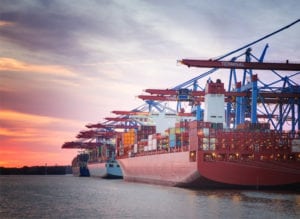Marlink Looks to New Services to Cater to Maritime Demand
[Via Satellite 08-04-2016] Maritime connectivity provider Marlink is seeing an uptick in demand across both merchant and cruise markets, compensating for dips in the oil and offshore segments, which Tore Morten Olsen, president of maritime at Marlink, expects to continue into 2017.
“The oil price will probably continue slowly upwards but it takes time before the maritime markets related to the oil industry will come back to normal levels. We follow the trends closely at the same time as we also see new business coming in from the markets that are more challenged these days. This is in part due to the fact that optimal communication services can achieve efficiencies, helping operators to save money by working smarter and making more use of connected software and data,” Olsen told Via Satellite.
Driving the merchant shipping market is the ability to use software and sensors to monitor key parameters onboard vessels, such as fuel consumption, with the aim of operating more efficiently and reducing costs, according to Olsen. There is also a need for connectivity for crew, electronic document handling, Machine-to-Machine (M2M), telemedicine, entertainment and education.
“The cruise/ferry market is also strong,” Olsen said, pointing to recent contracts with MSC Cruises and Stena Line, which Marlink has just upgraded to new systems. “For passenger vessels, high-end, integrated communication services have become a new way for companies to market their services and social media is the new marketing channel for the cruise industry.”
With the goal of providing “seamless” online access for cruise ships, Marlink has developed services that deliver connectivity for thousands of guest on board on what essentially amounts to a floating village. “But even for shorter ferry connections, there is potential for hundreds of passengers wanting to be online at the same time,” said Olsen.
This increase in demand is coming up against pressures to provide more and cost-effective capacity for maritime players, Brad Grady, senior analyst at Northern Sky Research (NSR) explained in an earlier interview with Via Satellite.
“There is a lot of pressure on pricing that’s coming out from end users who have a lower ability to pay because their economics and business-cases are getting pushed, and from the capacity that’s coming online,” said Grady.
To cater to this hunger for more and lower-priced capacity, Marlink is adding High Throughput Satellite (HTS) resources into its portfolio, such as Intelsat’s EpicNG, Inmarsat’s Global Xpress and Telenor’s Thor 7, which Olsen said will provide access to more bandwidth at affordable rates for ship owners that are looking to invest in connectivity.
“The demand for more bandwidth is already there,” said Olsen. “The trend is very similar to on shore [demand], though the maritime sector trails, of course. However, there is more need now for social media access, banking, M2M services, etc., as they become even more integral to our personal lives and business, also at sea.”
The company is also looking to increase its value-added services for ship operators, which can help open the door to new opportunities in data analytics and onboard content for both the vessels and the connectivity provider.
“Recent additions to our business-critical solutions portfolio include XChange Media, a new crew-focused solution designed to deliver the best in news, sports and entertainment multimedia content,” said Olsen, who also points to a new telemedicine system the company is releasing this September. The system aims to massively improve health and safety for crew and passengers on board by enabling secure live video and data communication with medical professionals on shore.
To increase its portfolio of value-added services, Marlink is also pursuing partnerships with systems providers to deliver new value-added services to vessel operators. One instance of this is a close partnership the company has developed with maritime IT company Palantir, which has enabled Marlink to integrate deep IT monitoring with their connectivity services.
“We can access a vessel’s entire IT network and fix issues remotely, which also has a green footprint with less physical intervention on board. This saves a huge amount of money for our customers. As an example, within a year of using the Palantir KeepUp@Sea together with Marlink connectivity, Stolt Tankers’ had a 40 percent reduction on their IT budget compared to what it was before,” said Olsen.
The Palantir solution, enabled through Marlink connectivity, allows ship owners to standardize and automate vessel IT-management, with the aim to improve operational stability and reduce support costs. Shipping company CMA CGM also signed a contract in June to roll out the KeepUp@Sea service on 110 vessels, and Olsen says the company is expecting to help them achieve similar IT management savings.
Going forward, Olsen says the company is looking to provide open, technology-agnostic, multi-band communication solutions.
